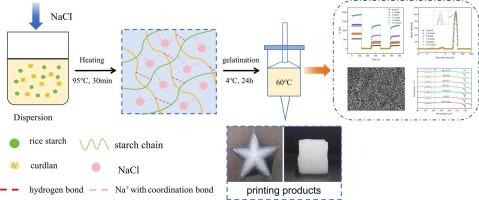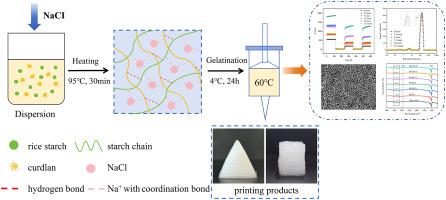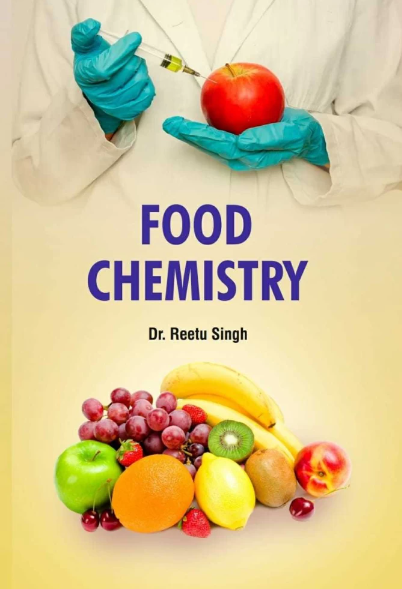Effects of sodium chloride on the textural attributes, rheological properties, microstructure, and 3D printing performance of rice starch-curdlan composite gel
IF 8.5
1区 农林科学
Q1 CHEMISTRY, APPLIED
引用次数: 0
Abstract
This study explores the impact of varying concentrations of salt ions (0, 2.5, 5, 7.5, 10, and 12.5 mmol) on the physicochemical properties and 3D-printing performance of rice starch-curdlan composite gel. The relationship between gel structure, properties, printability, and printing accuracy was clarified through the evaluation of each parameter. The inclusion of an appropriate concentration of NaCl positively influenced the properties and printing characteristics of the composite gel. Specifically, a NaCl concentration of 7.5 mmol yielded the highest printing performance, achieving 98.61 % accuracy. Microstructural analysis indicates that the addition of ions promoted the formation of a denser network structure in the composite gel. Fourier-transform infrared spectroscopy reveals enhanced hydrogen bonding in the rice starch-curdlan gels with the addition of NaCl. Lastly, dysphagia testing demonstrates that the composite gels with 0–5 mmol NaCl concentrations exhibited grade 5 characteristics (clastic and wet) with satisfactory swallowing performance.


氯化钠对大米淀粉-凝胶复合凝胶的纹理属性、流变特性、微观结构和 3D 打印性能的影响
本研究探讨了不同浓度的盐离子(0、2.5、5、7.5、10 和 12.5 mmol)对大米淀粉-凝胶复合凝胶的理化性质和三维打印性能的影响。通过对各参数的评估,阐明了凝胶结构、性能、可打印性和打印精度之间的关系。加入适当浓度的氯化钠会对复合凝胶的性能和打印特性产生积极影响。具体来说,氯化钠浓度为 7.5 mmol 时,印刷性能最高,精确度达到 98.61%。微观结构分析表明,离子的加入促进了复合凝胶中更致密网络结构的形成。傅立叶变换红外光谱显示,加入氯化钠后,大米淀粉-凝胶中的氢键作用增强。最后,吞咽困难测试表明,氯化钠浓度为 0-5 毫摩尔的复合凝胶具有 5 级特性(碎屑和湿润),吞咽性能令人满意。
本文章由计算机程序翻译,如有差异,请以英文原文为准。
求助全文
约1分钟内获得全文
求助全文
来源期刊

Food Chemistry
工程技术-食品科技
CiteScore
16.30
自引率
10.20%
发文量
3130
审稿时长
122 days
期刊介绍:
Food Chemistry publishes original research papers dealing with the advancement of the chemistry and biochemistry of foods or the analytical methods/ approach used. All papers should focus on the novelty of the research carried out.
 求助内容:
求助内容: 应助结果提醒方式:
应助结果提醒方式:


